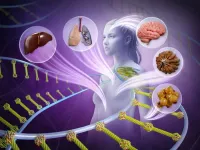(Press-News.org) UNIVERSITY PARK, Pa. — A biomaterial that can mimic certain behaviors within biological tissues could advance regenerative medicine, disease modeling, soft robotics and more, according to researchers at Penn State.
Materials created up to this point to mimic tissues and extracellular matrices (ECMs) — the body’s biological scaffolding of proteins and molecules that surrounds and supports tissues and cells — have all had limitations that hamper their practical applications, according to the team. To overcome some of those limitations, the researchers developed a bio-based, “living” material that encompasses self-healing properties and mimics the biological response of ECMs to mechanical stress.
They published their results in Materials Horizons, where the research was also featured on the cover of the journal.
“We developed a cell-free — or acellular — material that dynamically mimics the behavior of ECMs, which are key building blocks of mammalian tissues that are crucial for tissue structure and cell functions,” said corresponding author Amir Sheikhi, associate professor of chemical engineering and the Dorothy Foehr Huck and J. Lloyd Huck Early Career Chair in Biomaterials and Regenerative Engineering.
According to the researchers, previous iterations of their material — a hydrogel, or water-rich polymer network — were synthetic and lacked the desired combination of mechanical responsiveness and biological mimicry of ECMs.
“Specifically, these materials need to replicate nonlinear strain-stiffening, which is when ECM networks stiffen under strain caused by physical forces exerted by cells or external stimuli,” Sheikhi said, explaining nonlinear strain-stiffening is important for providing structural support and facilitating cell signaling. “The materials also need to replicate the self-healing properties necessary for tissue structure and survival. Prior synthetic hydrogels had difficulties in balancing material complexity, biocompatibility and mechanical mimicry of ECMs.”
The team addressed these limitations by developing acellular nanocomposite living hydrogels (LivGels) made from “hairy” nanoparticles. The nanoparticles are composed of nanocrystals, or “nLinkers,” with disordered cellulose chains, or “hairs,” at the ends. These hairs introduce anisotropy, meaning the nLinkers have different properties depending on their directional orientation and allow dynamic bonding with biopolymer networks. In this case, the nanoparticles bonded with a biopolymeric matrix of modified alginate, which is a natural polysaccharide found in brown algae.
“These nLinkers form dynamic bonds within the matrix that enable strain-stiffening behavior, that is, mimicking ECM's response to mechanical stress; and self-healing properties, which restore integrity after damage,” Sheikhi said, noting that the researchers used rheological testing, which measures how material behaves under various stressors, to measure how rapidly the LivGels recovered their structure after high strain. “This design approach allowed fine-tuning of the material's mechanical properties to match those of natural ECMs.”
Critically, Sheikhi said, this material is entirely made of biological materials and avoids synthetic polymers with potential biocompatibility issues. Beyond mitigating the limitations of previously developed materials, LivGels achieve the dual traits of nonlinear mechanics and self-healing without sacrificing structural integrity. The nLinkers specifically facilitate dynamic interactions that allow precise control of stiffness and strain-stiffening properties. Taken together, the design approach converts bulk, static hydrogels to dynamic hydrogels that closely mimic ECMs.
The potential applications include scaffolding for tissue repair and regeneration within regenerative medicine, simulating tissue behavior for drug testing and creating realistic environments for studying disease progression. The researchers said it could also be used for 3D bioprinting customizable hydrogels or for developing soft robotics with adaptable mechanical properties.
“Our next steps include optimizing LivGels for specific tissue types, exploring in vivo applications for regenerative medicine, integrating LivGels with 3D bioprinting platforms and investigating potential in dynamic wearable or implantable devices,” Sheikhi said.
Roya Koshani, a chemical engineering post-doctoral scholar at Penn State, and Sina Kheirabadi, a doctoral candidate in chemical engineering at Penn State, were co-authors on the paper. Sheikhi is also affiliated with the Departments of Biomedical Engineering, of Chemistry and of Neurosurgery, and with the Huck Institutes of the Life Sciences.
Support for this research was provided by Penn State, including from: the Dorothy Foehr Huck and J. Lloyd Huck Early Career Chair; the Convergence Center for Living Multifunctional Material Systems and the Cluster of Excellence Living, Adaptive and Energy-autonomous Materials Systems Living Multifunctional Materials Collaborative Research Seed Grant Program; the Materials Research Institute; and the College of Engineering Materials Matter at the Human Level seed grants.
END
Novel ‘living’ biomaterial aims to advance regenerative medicine
2025-02-06
ELSE PRESS RELEASES FROM THIS DATE:
Warding off superbugs with a pinch of turmeric
2025-02-06
In 2017, a tragic incident unfolded in a Nevada hospital. A woman, admitted for pneumonia, tragically succumbed to multiple organ failure and sepsis. The culprit? A strain of bacteria that had developed resistance to a staggering 26 different antibiotics. These superbugs, or antibiotic-resistant bacteria, stand as one of the most pressing public health threats globally.
Joining the effort to fight these deadly pathogens, researchers at Texas A&M have now shown that curcumin, the compound that gives turmeric its characteristic bright yellow color, can potentially be used to reduce antibiotic resistance.
The ...
Ophthalmic complications in patients on antidiabetic GLP-1 medications are concerning neuro-ophthalmologists
2025-02-06
BUFFALO, N.Y. — A small percentage of patients taking the extraordinarily popular GLP-1 medications have experienced vision problems, but a direct causal link with the drugs has not been established. That is the conclusion of a retrospective study published online on Jan. 30 in JAMA Ophthalmology.
The study focused on nine patients who had experienced vision problems while using semaglutide (brand names Wegovy and Ozempic) and tirzepatide (brand names Mounjaro and Zepbound).
The paper is one of several in the past ...
Physicians committee research policy director speaks today at hearing on taxpayer funded animal cruelty
2025-02-06
WASHINGTON, D.C. — Research Policy Director Elizabeth Baker from the Physicians Committee for Responsible Medicine, a national medical ethics and health advocacy group of 17,000 physicians, spoke today, Feb. 6, at a Congressional hearing focused on ending federally funded animal cruelty in research.
The U.S. House Oversight and Government Reform Subcommittee on Cybersecurity, Information Technology, and Government Innovation Chairwoman Nancy Mace (R-S.C.) announced the hearing in a news release on Monday, with plans to evaluate current animal cruelty funded by the federal government and explore opportunities ...
New technology lights way for accelerating coral reef restoration
2025-02-06
COLUMBUS, Ohio – Scientists have developed a novel tool designed to protect and conserve coral reefs by providing them with an abundance of feeding opportunities.
The device, dubbed the Underwater Zooplankton Enhancement Light Array (UZELA), is an autonomous, programmable underwater light that works to draw in nearby zooplankton, microscopic organisms that coral feed on.
After testing the submersible on two species of coral native to Hawaii over six months, researchers found that UZELA could ...
Electroencephalography may help guide treatments for language disorders
2025-02-06
Electroencephalography (EEG) may offer a more accessible alternative to functional magnetic resonance imaging (fMRI) for guiding transcranial direct current stimulation (tDCS) when treating aphasia. Researchers from Institute of Science Tokyo found an 80% agreement between EEG and fMRI in identifying brain regions activated during language tasks. Furthermore, EEG-guided tDCS improved picture-naming speed in participants, indicating its potential for innovative therapies in language disorders.
Many neurological disorders are directly linked to damage or deterioration in specific regions of the brain. For example, ...
Multinational research project shows how life on Earth can be measured from space
2025-02-06
Measurements and data collected from space can be used to better understand life on Earth.
An ambitious, multinational research project funded by NASA and co-led by UC Merced civil and environmental engineering Professor Erin Hestir demonstrated that Earth’s biodiversity can be monitored and measured from space, leading to a better understanding of terrestrial and aquatic ecosystems. Hestir led the team alongside University of Buffalo geography Professor Adam Wilson and Professor Jasper Slingsby from the University ...
Essential genome of malaria parasite Plasmodium knowlesi mapped
2025-02-06
Embargoed for release: Thursday, February 6, 2025, 2:00 PM ET
Key points:
Comprehensive genetic mapping of Plasmodium knowlesi, a zoonotic parasite that causes malaria, has revealed the genes required for malaria infection of the blood, and those driving drug resistance.
By identifying specific druggable targets and determinants of resistance, the map provides insights that could help the development of new therapeutics.
Boston, MA—A new, comprehensive map of all the genes essential for blood infections in Plasmodium knowlesi (P. ...
Ice streams move due to tiny ice quakes
2025-02-06
In brief:
• In Greenland, an international team of researchers led by ETH Zurich has discovered that countless tiny ice quakes take place deep inside ice streams.
• These quakes are responsible for the fact that ice streams also move with a continuous stick-slip motion and not only like viscous honey as previously considered.
• The researchers recorded seismic data from inside the ice stream using a fibre-optic cable in a 2,700-metre deep borehole.
The ...
Whale song has remarkable similarities to human speech in terms of efficiency
2025-02-06
Whale song can be as efficient as – and, in some cases, more efficient than – human communication, according to a new study in Science Advances. Meanwhile, new unrelated research in Science further investigates whale song’s adherence to a universal linguistic law, as observed in recordings of humpback whales.
Natural selection favors the pithy over the longwinded. For example, yelling “Duck!” is faster and far more effective than shouting “Be careful, there is an incoming projectile, and you need to move out of the way!” ...
Uncovered: How mice override instinctive fear responses
2025-02-06
Researchers have uncovered a neural mechanism in the brains of mice that enables them to override instinctive fear responses; dysfunction in this mechanism may contribute to inappropriate or excessive fear responses, they say. According to the findings, targeting these circuits could offer new therapeutic avenues for treating fear-related disorders like post-traumatic stress disorder and anxiety. Fear responses to visual threats, such as escaping from an approaching predator, are critical instinctive reactions for survival and are ...




